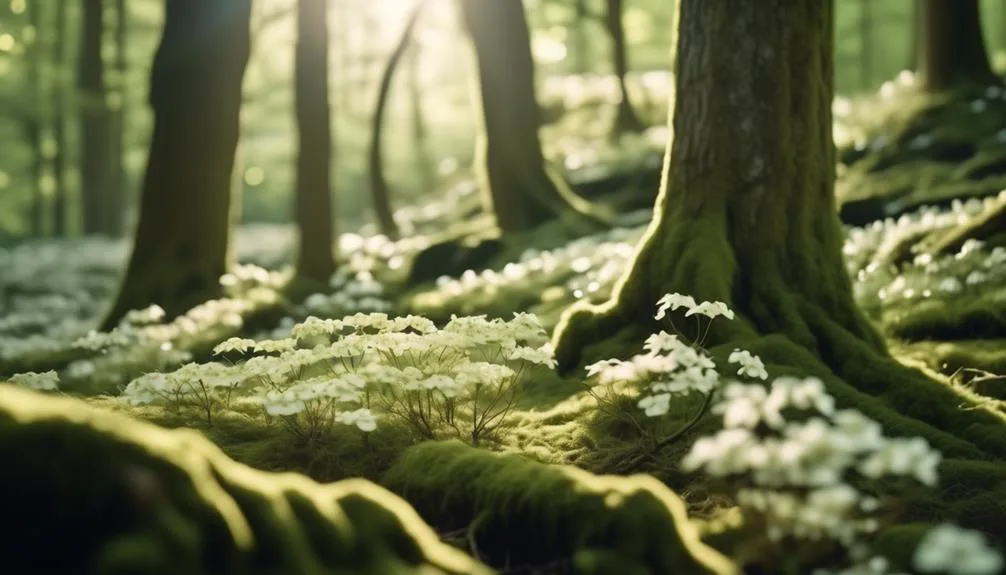Looking for the oldest dogwood trees in the US? They thrive in the Appalachian Mountains, Pacific Northwest forests, and the Southeast.
You'll also find them in ancient forests and botanical gardens, each with its own story.
The search for these majestic trees promises rich history and natural wonders.
Appalachian Mountains
Nestled within the rugged terrain of the Appalachian Mountains, the oldest dogwood trees thrive in a diverse and enchanting ecosystem. These ancient trees bear witness to centuries of history, their tree rings holding stories of changing climates and the passage of time.
The Appalachian Mountains provide a unique habitat for these dogwood trees, sheltering them and offering the perfect conditions for their growth. Sadly, these remarkable trees are now considered an endangered species, facing threats from habitat destruction and invasive species.
The conservation efforts in this region are crucial to ensuring the survival of these majestic trees for future generations to admire. As you explore the Appalachian Mountains, take a moment to appreciate the significance of these ancient dogwood trees and the delicate balance required to preserve their existence.
Pacific Northwest
Towering evergreen forests and snow-capped peaks define the breathtaking landscapes of the Pacific Northwest, where the iconic dogwood trees find a new home amidst the region's diverse ecosystems. The Pacific Northwest holds historical significance as it is home to some of the oldest and most majestic dogwood trees in the world. These ancient trees have witnessed centuries of history, standing as silent witnesses to the passing of time. Their delicate, four-petaled blossoms have adorned the region for generations, inspiring awe and wonder in all who behold them.
| Historical Significance | Pacific Northwest | Oldest Dogwood Trees |
|---|---|---|
| Centuries of history | Majestic | Silent witnesses |
| Iconic blossoms | Diverse ecosystems | Awe and wonder |
The Pacific Northwest's oldest dogwood trees are a testament to the enduring beauty and resilience of nature, captivating the hearts of all who encounter them.
Southeastern United States
The Pacific Northwest's legacy of ancient dogwood trees gives way to a new chapter of natural wonder in the Southeastern United States, where these iconic trees continue to thrive in a different yet equally captivating environment. Amidst the enchanting landscapes of the Southeast, ancient dogwood trees hold their own secrets and stories, waiting to be discovered.
Here, the tree rings of these majestic dogwoods bear witness to centuries of history, each ring a testament to the passage of time and the changing climate. As you explore the Southeastern United States, keep an eye out for these remarkable dogwood trees, which have stood the test of time and are living proof of the resilience of nature. Their presence serves as a powerful reminder of the impact of climate change on our natural world.
- Each tree ring tells a unique story of growth and environmental changes.
- The climate in the Southeast has shaped the growth and lifespan of these ancient dogwood trees.
- Dogwood trees in the Southeast provide valuable insight into the long-term effects of climate change on ecosystems.
- The Southeastern United States is home to some of the oldest and most resilient dogwood trees in the country.
Ancient Forests
ARTICLE TITLE: Oldest Dogwood Trees
PREVIOUS SUBTOPIC: 'Southeastern United States'
CURRENT SUBTOPIC: 'Ancient Forests'
Amidst the lush landscapes of the Southeast, ancient forests stand as monuments to the passage of time, offering a glimpse into the rich history and ecological diversity of the region. These biodiverse hotspots are home to a myriad of plant and animal species, some of which are found nowhere else on Earth. Conservation efforts are crucial to protect these ancient forests and the delicate balance of life within them. Climate change poses a significant threat, impacting ancient forests through shifts in temperature and precipitation patterns, leading to habitat disruption and species displacement. It's essential to raise awareness about the importance of these ancient forests and take action to preserve them for future generations.
| Biodiversity Hotspots | Conservation Efforts | Climate Change Impact on Ancient Forests |
|---|---|---|
| Southeast forests boast high biodiversity, supporting a wide array of species. | Conservation efforts focus on protecting habitats and preventing deforestation. | Climate change threatens ancient forests through habitat disruption and species displacement. |
Botanical Gardens
Nestled within the Southeast's diverse landscapes, botanical gardens showcase a stunning array of plant species, offering visitors a captivating insight into the region's botanical heritage and ecological significance.
As you explore these gardens, you'll find yourself immersed in a world of tree identification, learning to distinguish between the majestic dogwood and other indigenous tree species.
Botanical gardens also play a crucial role in plant conservation, preserving rare and endangered species through specialized cultivation and education programs. They serve as living laboratories, engaging visitors in the importance of protecting our natural environment.
Strolling through these gardens, you'll discover the vital role they play in safeguarding the region's botanical diversity, while gaining a deeper understanding of the interconnectedness of plant life within the Southeast's ecosystems.
Conclusion
Whether in the depths of ancient forests or within the curated landscapes of botanical gardens, the oldest dogwood trees stand as timeless symbols of natural beauty and resilience.
Their presence beckons us to ponder the enduring magnificence of the natural world and invites us to cherish and protect these living treasures for generations to come.

My interest in trees started when I first saw the giant sequoias in Yosemite.
I was a teenager then, and I remember thinking, “I need to learn more about this.”
That moment stuck with me.
A few years later, I went on to study forestry at Michigan Tech.
Since graduating, I’ve worked in a mix of hands-on tree care and community education.
I’ve spent over ten years helping people understand how to plant, maintain, and protect the trees in their neighborhoods.
I don’t see trees as just part of the landscape.
They are living things that make a real difference in our daily lives.
